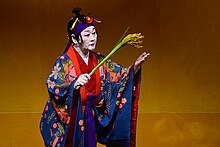| Kumiodori, traditional Okinawan musical theatre | |
|---|---|
 | |
| Country | Japan |
| Domains | Performing arts |
| Reference | 405 |
| Region | Asia and the Pacific |
| Inscription history | |
| Inscription | 2010 (5th session) |
| List | Representative |
 | |
Kumi odori (組踊, Okinawan: Kumi wudui) is a form of narrative traditional Ryūkyūan dance. Kumi odori or Kumi wudui means "combination dance" or "ensemble dance".
Originating in the Ryūkyūan capital of Shuri, Okinawa in 1719, the original purpose of this dance was to provide amusement and diversions, which were termed ukwanshin, for the Chinese diplomats who traveled to Ryūkyū. Tamagusuku Chokun, a Ryūkyūan courtier who lived from 1684 to 1734, is credited with the establishment of kumi odori as a frequently presented court demonstration. An amalgamation of several different types of East Asian dance, the kumi odori has continued to hold a place in Okinawan culture, and is now recognized by the Japanese government as an Important Intangible Cultural Property. In 2010 it was inscribed on the UNESCO Representative List of the Intangible Cultural Heritage of Humanity.[1] It remains today a prime example of native art sustained by the people of Okinawa.
- ^ "Kumiodori, traditional Okinawan musical theatre". UNESCO. Retrieved 2 May 2011.